Azmine Toushik Wasi
Kaleidoscope: In-language Exams for Massively Multilingual Vision Evaluation
Apr 09, 2025Abstract:The evaluation of vision-language models (VLMs) has mainly relied on English-language benchmarks, leaving significant gaps in both multilingual and multicultural coverage. While multilingual benchmarks have expanded, both in size and languages, many rely on translations of English datasets, failing to capture cultural nuances. In this work, we propose Kaleidoscope, as the most comprehensive exam benchmark to date for the multilingual evaluation of vision-language models. Kaleidoscope is a large-scale, in-language multimodal benchmark designed to evaluate VLMs across diverse languages and visual inputs. Kaleidoscope covers 18 languages and 14 different subjects, amounting to a total of 20,911 multiple-choice questions. Built through an open science collaboration with a diverse group of researchers worldwide, Kaleidoscope ensures linguistic and cultural authenticity. We evaluate top-performing multilingual vision-language models and find that they perform poorly on low-resource languages and in complex multimodal scenarios. Our results highlight the need for progress on culturally inclusive multimodal evaluation frameworks.
Preserving Cultural Identity with Context-Aware Translation Through Multi-Agent AI Systems
Mar 05, 2025Abstract:Language is a cornerstone of cultural identity, yet globalization and the dominance of major languages have placed nearly 3,000 languages at risk of extinction. Existing AI-driven translation models prioritize efficiency but often fail to capture cultural nuances, idiomatic expressions, and historical significance, leading to translations that marginalize linguistic diversity. To address these challenges, we propose a multi-agent AI framework designed for culturally adaptive translation in underserved language communities. Our approach leverages specialized agents for translation, interpretation, content synthesis, and bias evaluation, ensuring that linguistic accuracy and cultural relevance are preserved. Using CrewAI and LangChain, our system enhances contextual fidelity while mitigating biases through external validation. Comparative analysis shows that our framework outperforms GPT-4o, producing contextually rich and culturally embedded translations, a critical advancement for Indigenous, regional, and low-resource languages. This research underscores the potential of multi-agent AI in fostering equitable, sustainable, and culturally sensitive NLP technologies, aligning with the AI Governance, Cultural NLP, and Sustainable NLP pillars of Language Models for Underserved Communities. Our full experimental codebase is publicly available at: https://github.com/ciol-researchlab/Context-Aware_Translation_MAS
IITR-CIOL@NLU of Devanagari Script Languages 2025: Multilingual Hate Speech Detection and Target Identification in Devanagari-Scripted Languages
Dec 23, 2024



Abstract:This work focuses on two subtasks related to hate speech detection and target identification in Devanagari-scripted languages, specifically Hindi, Marathi, Nepali, Bhojpuri, and Sanskrit. Subtask B involves detecting hate speech in online text, while Subtask C requires identifying the specific targets of hate speech, such as individuals, organizations, or communities. We propose the MultilingualRobertaClass model, a deep neural network built on the pretrained multilingual transformer model ia-multilingual-transliterated-roberta, optimized for classification tasks in multilingual and transliterated contexts. The model leverages contextualized embeddings to handle linguistic diversity, with a classifier head for binary classification. We received 88.40% accuracy in Subtask B and 66.11% accuracy in Subtask C, in the test set.
INCLUDE: Evaluating Multilingual Language Understanding with Regional Knowledge
Nov 29, 2024



Abstract:The performance differential of large language models (LLM) between languages hinders their effective deployment in many regions, inhibiting the potential economic and societal value of generative AI tools in many communities. However, the development of functional LLMs in many languages (\ie, multilingual LLMs) is bottlenecked by the lack of high-quality evaluation resources in languages other than English. Moreover, current practices in multilingual benchmark construction often translate English resources, ignoring the regional and cultural knowledge of the environments in which multilingual systems would be used. In this work, we construct an evaluation suite of 197,243 QA pairs from local exam sources to measure the capabilities of multilingual LLMs in a variety of regional contexts. Our novel resource, INCLUDE, is a comprehensive knowledge- and reasoning-centric benchmark across 44 written languages that evaluates multilingual LLMs for performance in the actual language environments where they would be deployed.
Graph Neural Networks in Supply Chain Analytics and Optimization: Concepts, Perspectives, Dataset and Benchmarks
Nov 13, 2024Abstract:Graph Neural Networks (GNNs) have recently gained traction in transportation, bioinformatics, language and image processing, but research on their application to supply chain management remains limited. Supply chains are inherently graph-like, making them ideal for GNN methodologies, which can optimize and solve complex problems. The barriers include a lack of proper conceptual foundations, familiarity with graph applications in SCM, and real-world benchmark datasets for GNN-based supply chain research. To address this, we discuss and connect supply chains with graph structures for effective GNN application, providing detailed formulations, examples, mathematical definitions, and task guidelines. Additionally, we present a multi-perspective real-world benchmark dataset from a leading FMCG company in Bangladesh, focusing on supply chain planning. We discuss various supply chain tasks using GNNs and benchmark several state-of-the-art models on homogeneous and heterogeneous graphs across six supply chain analytics tasks. Our analysis shows that GNN-based models consistently outperform statistical Machine Learning and other Deep Learning models by around 10-30% in regression, 10-30% in classification and detection tasks, and 15-40% in anomaly detection tasks on designated metrics. With this work, we lay the groundwork for solving supply chain problems using GNNs, supported by conceptual discussions, methodological insights, and a comprehensive dataset.
Balancing Power and Ethics: A Framework for Addressing Human Rights Concerns in Military AI
Nov 10, 2024Abstract:AI has made significant strides recently, leading to various applications in both civilian and military sectors. The military sees AI as a solution for developing more effective and faster technologies. While AI offers benefits like improved operational efficiency and precision targeting, it also raises serious ethical and legal concerns, particularly regarding human rights violations. Autonomous weapons that make decisions without human input can threaten the right to life and violate international humanitarian law. To address these issues, we propose a three-stage framework (Design, In Deployment, and During/After Use) for evaluating human rights concerns in the design, deployment, and use of military AI. Each phase includes multiple components that address various concerns specific to that phase, ranging from bias and regulatory issues to violations of International Humanitarian Law. By this framework, we aim to balance the advantages of AI in military operations with the need to protect human rights.
* Accepted for oral (only 3 papers are selected!) Harms and Risks of AI in the Military Workshop (HRAIM 2024) at Mila Quebec (https://www.harms-risks-ai-military.org/accepted-abstracts.html#:~:text=Balancing%20Power%20and%20Ethics)
Exploring Possibilities of AI-Powered Legal Assistance in Bangladesh through Large Language Modeling
Oct 22, 2024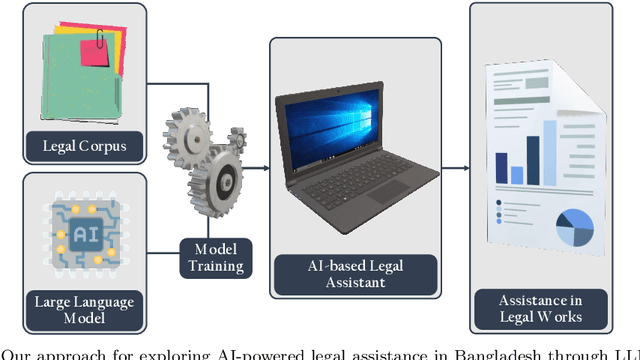

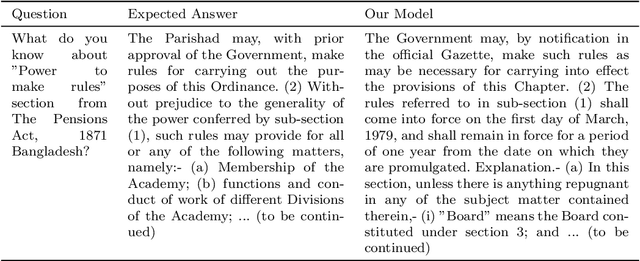

Abstract:Purpose: Bangladesh's legal system struggles with major challenges like delays, complexity, high costs, and millions of unresolved cases, which deter many from pursuing legal action due to lack of knowledge or financial constraints. This research seeks to develop a specialized Large Language Model (LLM) to assist in the Bangladeshi legal system. Methods: We created UKIL-DB-EN, an English corpus of Bangladeshi legal documents, by collecting and scraping data on various legal acts. We fine-tuned the GPT-2 model on this dataset to develop GPT2-UKIL-EN, an LLM focused on providing legal assistance in English. Results: The model was rigorously evaluated using semantic assessments, including case studies supported by expert opinions. The evaluation provided promising results, demonstrating the potential for the model to assist in legal matters within Bangladesh. Conclusion: Our work represents the first structured effort toward building an AI-based legal assistant for Bangladesh. While the results are encouraging, further refinements are necessary to improve the model's accuracy, credibility, and safety. This is a significant step toward creating a legal AI capable of serving the needs of a population of 180 million.
Dhoroni: Exploring Bengali Climate Change and Environmental Views with a Multi-Perspective News Dataset and Natural Language Processing
Oct 22, 2024Abstract:Climate change poses critical challenges globally, disproportionately affecting low-income countries that often lack resources and linguistic representation on the international stage. Despite Bangladesh's status as one of the most vulnerable nations to climate impacts, research gaps persist in Bengali-language studies related to climate change and NLP. To address this disparity, we introduce Dhoroni, a novel Bengali (Bangla) climate change and environmental news dataset, comprising a 2300 annotated Bangla news articles, offering multiple perspectives such as political influence, scientific/statistical data, authenticity, stance detection, and stakeholder involvement. Furthermore, we present an in-depth exploratory analysis of Dhoroni and introduce BanglaBERT-Dhoroni family, a novel baseline model family for climate and environmental opinion detection in Bangla, fine-tuned on our dataset. This research contributes significantly to enhancing accessibility and analysis of climate discourse in Bengali (Bangla), addressing crucial communication and research gaps in climate-impacted regions like Bangladesh with 180 million people.
GReFEL: Geometry-Aware Reliable Facial Expression Learning under Bias and Imbalanced Data Distribution
Oct 21, 2024Abstract:Reliable facial expression learning (FEL) involves the effective learning of distinctive facial expression characteristics for more reliable, unbiased and accurate predictions in real-life settings. However, current systems struggle with FEL tasks because of the variance in people's facial expressions due to their unique facial structures, movements, tones, and demographics. Biased and imbalanced datasets compound this challenge, leading to wrong and biased prediction labels. To tackle these, we introduce GReFEL, leveraging Vision Transformers and a facial geometry-aware anchor-based reliability balancing module to combat imbalanced data distributions, bias, and uncertainty in facial expression learning. Integrating local and global data with anchors that learn different facial data points and structural features, our approach adjusts biased and mislabeled emotions caused by intra-class disparity, inter-class similarity, and scale sensitivity, resulting in comprehensive, accurate, and reliable facial expression predictions. Our model outperforms current state-of-the-art methodologies, as demonstrated by extensive experiments on various datasets.
HRGraph: Leveraging LLMs for HR Data Knowledge Graphs with Information Propagation-based Job Recommendation
Aug 24, 2024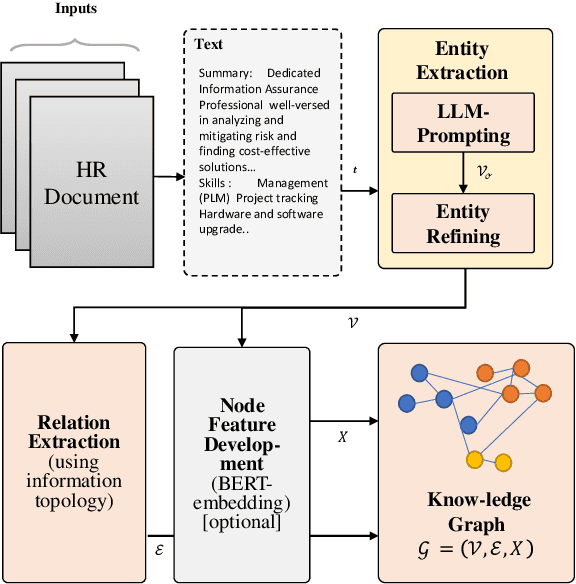
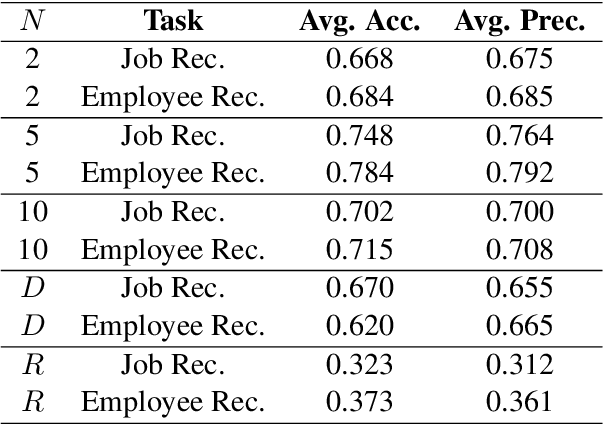

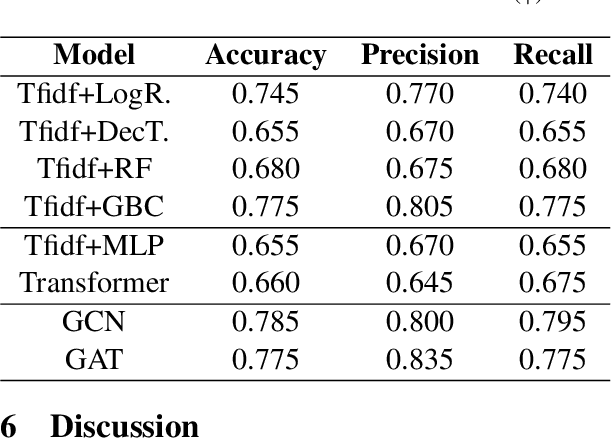
Abstract:Knowledge Graphs (KGs) serving as semantic networks, prove highly effective in managing complex interconnected data in different domains, by offering a unified, contextualized, and structured representation with flexibility that allows for easy adaptation to evolving knowledge. Processing complex Human Resources (HR) data, KGs can help in different HR functions like recruitment, job matching, identifying learning gaps, and enhancing employee retention. Despite their potential, limited efforts have been made to implement practical HR knowledge graphs. This study addresses this gap by presenting a framework for effectively developing HR knowledge graphs from documents using Large Language Models. The resulting KG can be used for a variety of downstream tasks, including job matching, identifying employee skill gaps, and many more. In this work, we showcase instances where HR KGs prove instrumental in precise job matching, yielding advantages for both employers and employees. Empirical evidence from experiments with information propagation in KGs and Graph Neural Nets, along with case studies underscores the effectiveness of KGs in tasks such as job and employee recommendations and job area classification. Code and data are available at : https://github.com/azminewasi/HRGraph
* 7 Pages, 4 Figures. View in ACL Anthology: https://aclanthology.org/2024.kallm-1.6/
 Add to Chrome
Add to Chrome Add to Firefox
Add to Firefox Add to Edge
Add to Edge